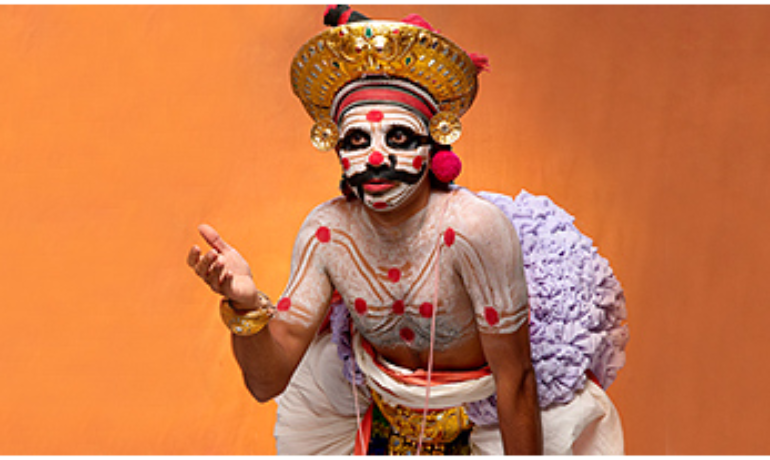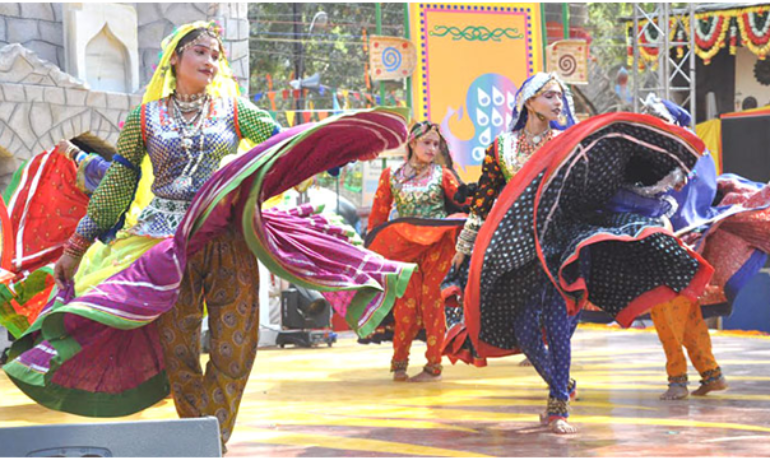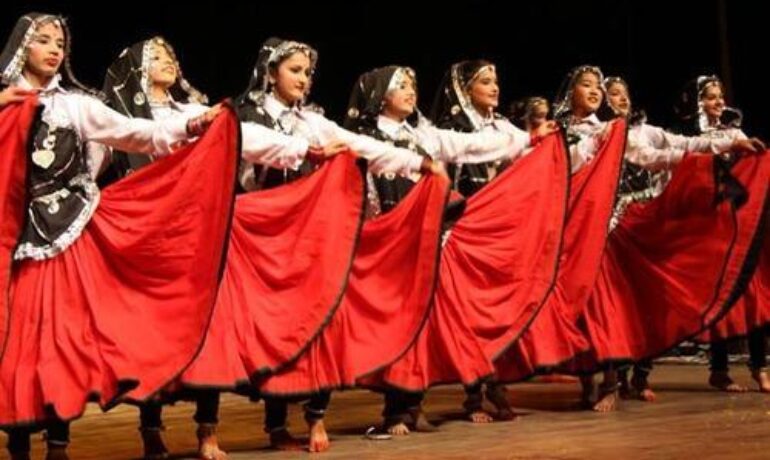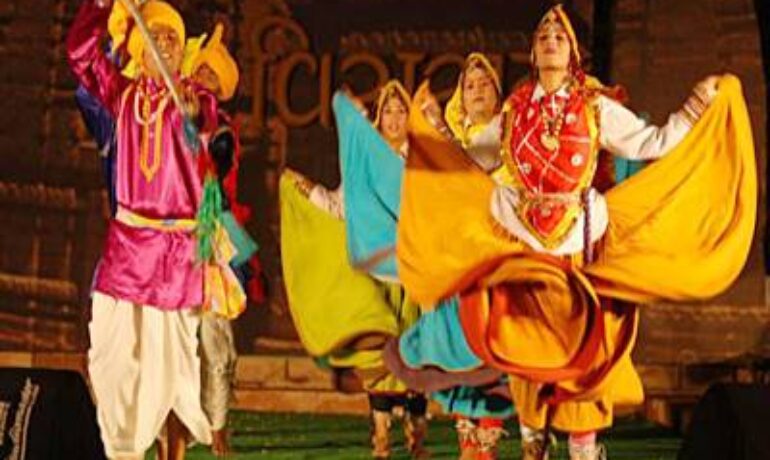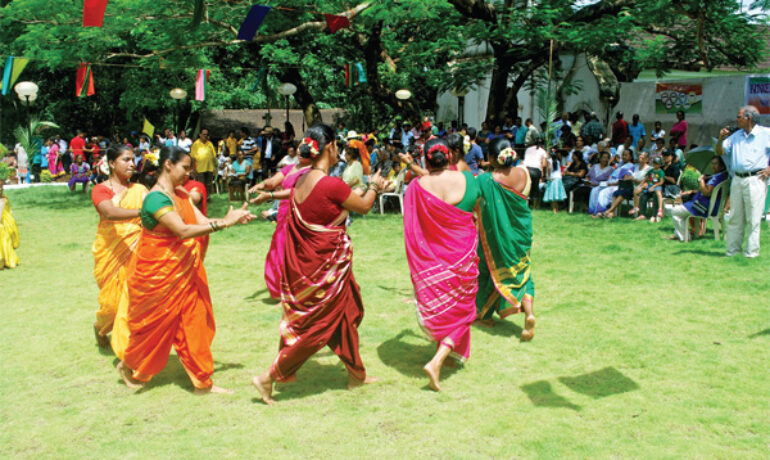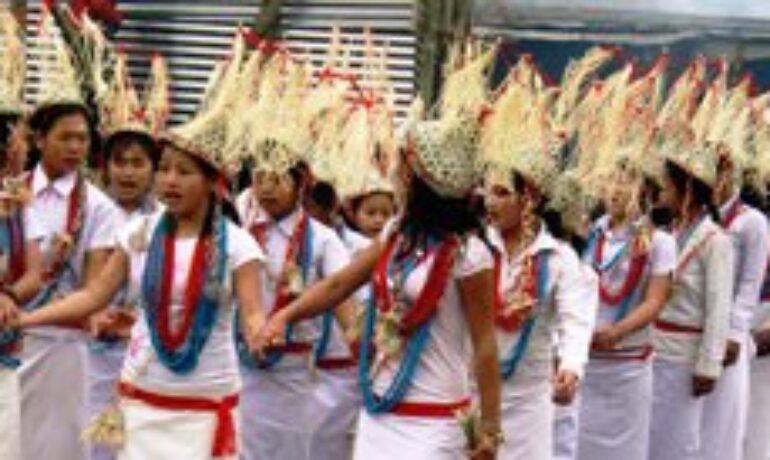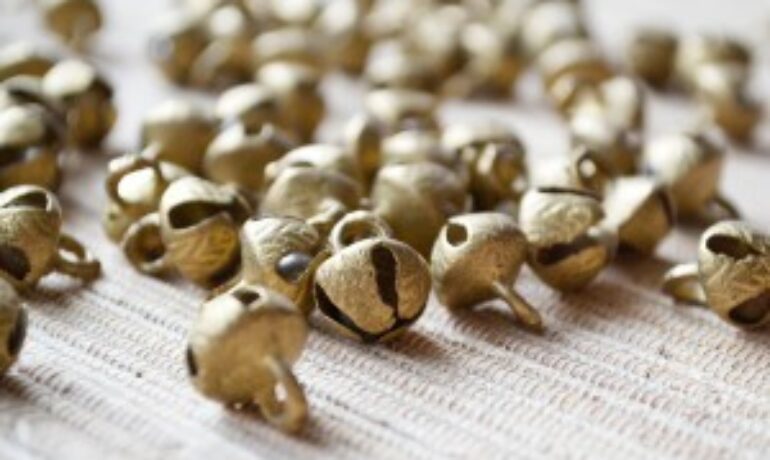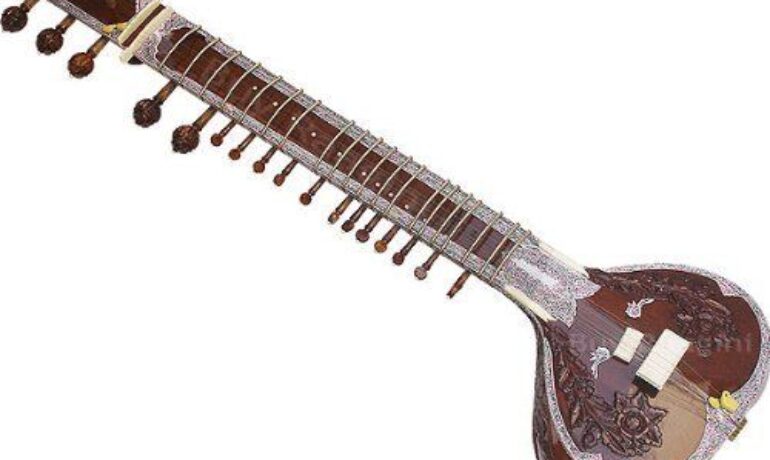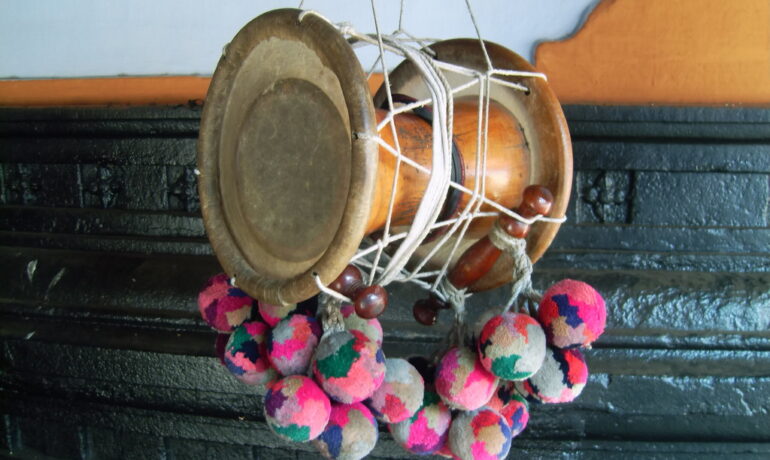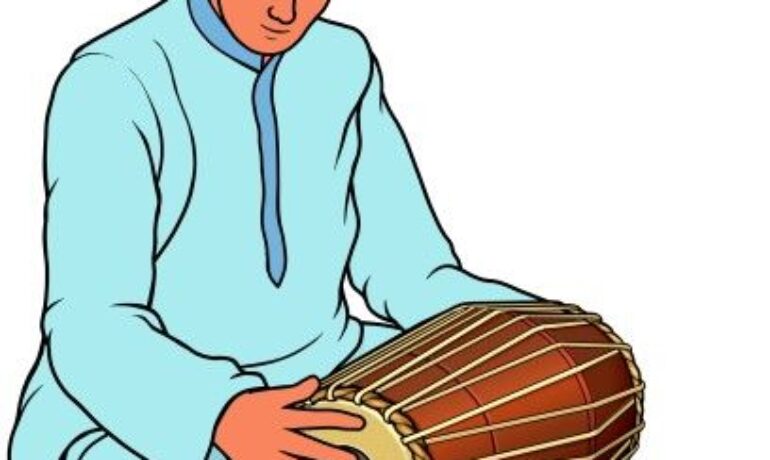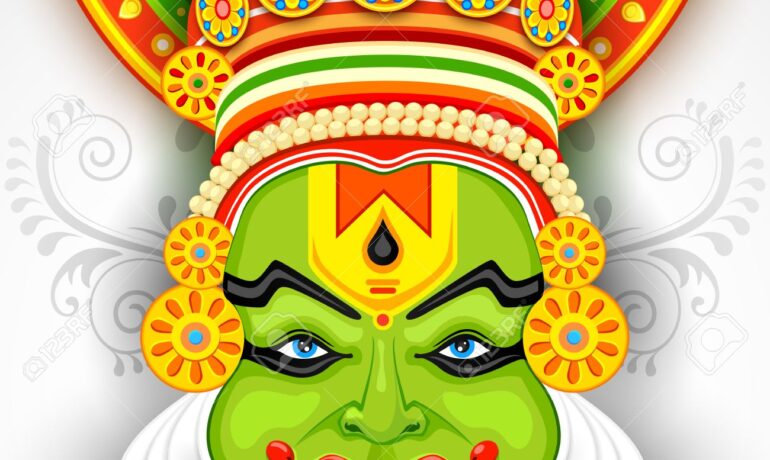Folk music of Uttarakhand The folk music of Uttarakhand refers to the traditional and contemporary songs of Kumaon and Garhwal regions in the foothills of Himalayas. This music has its root in the lap of nature and the hilly terrain of the region. The folk songs of Uttarakhand are a reflection of the cultural heritage and the way people live their […]
Read MoreThe Ras lila or Ras dance or Krishna Tandava, is part of the traditional story of Krishna described in Hindu scriptures such as the Bhagavata Purana and literature such as the Gita Govinda, where he dances with Radha and her sakhis (gopis). The Indian classical dance of Kathak evolved from the ‘Raslila of Braj and Manipuri Classical Dance’ (Vrindavana) also known as Natwari Nritya, which was revived in 1960s by the Kathak dancer, Uma Sharma. The term, rasa meaning […]
Read MoreNautanki is one of the most popular folk performance forms of South Asia, particularly in northern India. Before the advent of Bollywood (the Hindi film industry), Nautanki was the biggest entertainment medium in the villages and towns of northern India. Nautanki’s rich musical compositions and humorous, entertaining storylines hold a strong influence over rural people’s imagination. […]
Read MoreJhainta This dance gives energy to the dancers and is said to make the dancers even bolder as they face the hardships in life. Commonly practiced in Kumaon district of the Himachal Pradesh, this dance form rejuvenates the dancers. This dance is performed by both men and women. Men and women whirl past each other […]
Read MoreThali, Jadda Thali is a graceful dance form performed by women of Kumaon region in Uttrakhand weddings. They have to balance a metal plate on their head through the dance while taking spins. Jadda and Jainta are another traditional dance forms enacted by men and women of Kumaon region. Both men and women come together, forms a circle and […]
Read MoreJagar dance Jagar dance is a famous dance form that originated in Uttarakhand amongst the Kumaon and Garhwal region. The Jagar dance and ritual showcases how the spirits of the ancestors are worshipped amongst the local tribes. … The word Jagar for the dance and ritual comes from a Sanskrit word which means ‘To Wake’.
Read MoreChholiya (or Chhaliya) is a dance form practised in the Kumaon division of Uttarakhand, India. It is basically a sword dance accompanying a marriage procession but now it is performed on many auspicious occasions. It is especially popular in the districts of Almora, Bageshwar, Champawat and Pithoragarh of Kumaon division and has even spread to the Garhwal division. This sword dance has a history of more than a thousand years […]
Read MoreLebang Boomani dance (also Lebang Bumani) is a harvest dance performed by the Tripuri people of Tripura, India. It is one of two dances associated with the Tripuris, the other being the Garia dance that is performed at the time of sowing crops. Both men and women participate in the Lebang Boomani dance. The men use bamboo clappers called tokkas […]
Read MoreGoria dance or Garia dance is a dance of the Tripuri people of the Indian state of Tripura. It is performed during Goria puja, the festival to celebrate the sowing of new crops and prayer for a good harvest during the month of Baisakha. In the western calendar, the dancing occurs after the middle of […]
Read MoreHojagiri is a folk dance, performed in the state of Tripura, India by the Bru(Reang) clan one of the Tripuri community. It is performed by women and young girls, about 4 to 6 members in a team, singing, balancing on an earthen pitcher, and managing other props such as a bottle on the head and […]
Read MoreThe Perini siva Thandavam is a dance form usually performed by males. It is called ‘Dance of Warriors’. Warriors before leaving to the battlefield enact this dance before the idol of Lord Śiva (Siva). The dance form, Perini, reached its pinnacle during the rule of the ‘Kakatiyas’ who established their dynasty at Warangal and ruled for almost […]
Read MoreOyilattam is a folk dance with origins in the Madurai region of Tamil Nadu. The dance has its origins in southern Tamil Nadu and is primarily performed in Madurai district, Tirunelveli district, and Tiruchirapalli district. It was traditionally a dance where a few men would stand in a row with two kerchiefs perform rhythmic steps […]
Read MorePuliyattam (means Tiger Dance) is an old folk art dance of Tamil country. A highly exuberant and cultural festival, this dance form usually comprises a troupe of 6 performers aping the movements of the majestic, predatory tigers. Their bodies are painted by the painstaking efforts of local artists in vibrant yellow and black to resemble […]
Read MoreBommalattam or puppet show Puppet shows are held in every village during festivals and fairs. Many different kinds of puppets are used for this show – cloth, wood, leather, etc. They are manipulated through strings or wires. The puppeteers stand behind a screen and the puppets are held in front. The stories enacted in the […]
Read MoreTerukkuttu is a Tamil street theatre form practiced in Tamil Nadu state of India and Tamil-speaking regions of Sri Lanka.Terukuttu is a form of entertainment, a ritual, and a medium of social instruction. The terukkuttu plays various themes. One theme is from the Tamil language versions of the Hindu epic Mahabharata, focusing on the character […]
Read MoreKavadi Aattam (“Burden Dance”) is a ceremonial sacrifice and offering practiced by devotees during the worship of Lord Murugan,[1] the Hindu God of War.It is a central part of the festival of Thaipusam and emphasizes debt bondage. The kavadi (“burden”) itself is a physical burden, the bearing of which is used by the devotee to implore Murugan for assistance, usually on behalf of a loved […]
Read MoreKavadi Aattam (“Burden Dance”) is a ceremonial sacrifice and offering practiced by devotees during the worship of Lord Murugan,[1] the Hindu God of War.It is a central part of the festival of Thaipusam and emphasizes debt bondage. The kavadi (“burden”) itself is a physical burden, the bearing of which is used by the devotee to implore Murugan for assistance, usually on behalf of a loved […]
Read MoreKummi is a folk dance, popular in Tamil Nadu and Kerala in India, danced mostly by Tamil women in circles. Dancing may be different. In some places, it is very simple, with rhythmic clapping or beating of the drums. In other places, dancers imitate various harvesting activities. Kummi often accompanies by songs, called “Kummi songs”. […]
Read MoreMaruni is a Sikkimese dance, also popular in nearby Nepal, Darjeeling, Assam, Bhutan and Myanmar. It is the oldest and most famous dance of the Nepalese community residing in these regions, originally danced as part of the Tihar festival.Dressed colorfully with rich ornaments, the dancers dance to commemorate “the victory of good over evil”, accompanied by the traditional Nepali Naumati Baja orchestra.Maruni Nach has been […]
Read MoreThe cham dance is a lively masked and costumed dance associated with some sects of Tibetan Buddhism and Buddhist festivals. The dance is accompanied by music played by monks using traditional Tibetan musical instruments. The dances often offer moral instruction relating to karuṇā (compassion) for sentient beings and are held to bring merit to all who perceive them. Chams are considered a form of meditation and an offering to the gods. The leader of […]
Read MoreSinghi Chham or Kanchendzonga Dance is a lion dance form in Sikkim whereby the dancers perform in a lion costume that represents the snow lion. It is a dance of the Bhutia people and was said to have been introduced by Chador Namgyal, the third Chogyal of Sikkim, in the 18th century. It is usually […]
Read Morehe Kalbelia dance, performed as a celebration, is an integral part of Kalbelia culture. Their dances and songs are a matter of pride and a marker of identity for the Kalbelias and they represent the creative adaptation of this community of snake charmers to changing socioeconomic conditions and their own role in rural Rajasthani society. The dancers […]
Read MoreJhulan Yatra is one of the most important festivals for the followers of Lord Krishna celebrated in the monsoon month of Shravan. After Holi and Janmashthami, it is the biggest and most popular religious occasion of the Vaishnavas. Known for its spectacular display of decorated swings, song, and dance, Jhulan is a joyful festival celebrating […]
Read MoreGhoomar is a traditional folk dance of Rajasthan. It was the Bhil tribe who performed it to worship Goddess Sarasvati which was later embraced by other Rajasthani communities. The dance is chiefly performed by veiled women who wear flowing dresses called Ghaghara. It was ranked 4th in the list of “Top 10 local dances around […]
Read MoreThe sound of the Shankha plays an important role when something significant begins in Sanatana Dharma (Hindu Dharma) and Buddhism. Shankha represents luster, brilliance, purity, and auspicious start. It is viewed as a devout article and is utilized in all religious ceremonies. It is widely believed that the first use of the Shankha took place […]
Read MoreJindua is one type of Song, but now the days it is performed with the dance steps & singing by couples for expressing their feelings about each other. Even today this is quite common in group gatherings and even in school events. Description Jindua is a very common folk dance, where there is a pair – […]
Read MoreWhat is Luddi Dance? This is also a male dance of Punjab. It is danced to celebrate a victory in any field. Usually performed by the males in the folk culture, the Luddi dance is performed as a celebratory dance that celebrates victory of any Punjabi in any field. The dance movements in this dance […]
Read MoreSammi is a traditional dance form originating from the tribal communities of Punjab. The dance is popular in the Sandalbar area of Punjab, Pakistan. Costume The dancers are dressed in bright colored kurtas and full flowing skirts called lehengas. A peculiar silver hair ornament is associated with this dance. Performance Like Giddha it is danced in a circle. The dancers stand in a ring and swing […]
Read MoreKikli, is one of the folk dances of Punjabi females performed by two girls holding hands and twirling each other in a circle, and balancing their positions in circular motions. It is generally popular in young girls and performed in pairs. A variety of songs are used with clapping. Dancing style It is more of […]
Read MoreJhumar or Jhoomar is a lively form of music and dance that originated in the Multan and Balochistan, also thrived in Sandalbar areas of Punjab. It is slower and more rhythmic form. The word “Jhumar” comes from Jhum/Jhoom, which means Swaying. The songs evoke a quality which reminds of swaying. Though the content of these […]
Read MoreUttarakhand music has irreplaceable wisdom of inflection that enhances the beauty of the state. The music here is a combination of poetic quality and the music of the Kumaon and Garhwal region varies from each other. A mix of folk tradition, native songs as well as folk songs go together with the numerous musical tools which in turn augments […]
Read MoreDance music is music composed specifically to facilitate or accompany dancing. It can be either a whole musical piece or part of a larger musical arrangement. In terms of performance, the major categories are live dance music and recorded dance music. While there exist attestations of the combination of dance and music in ancient times, the earliest Western dance music that […]
Read MoreDuring the mid-1950s in the United States and the United Kingdom, pop is a genre of popular music that originated in its modern form. Although the former describes all music that is popular and includes many disparate styles, the terms popular music and pop music are often used interchangeably. During the 1950s and 1960s, pop […]
Read MoreHindi film songs or filmi songs are songs featured in Bollywood films. The song and dances in the Indian cinemas have become a characteristic motif of Hindi cinema which gives it enduring popular appeal, cultural value, and context. Hindi film songs derive their inspiration from both classical and modern sources form a predominant component of […]
Read MoreIndians got instigated patriotically through music since the era of the freedom struggle. few songs like Jana Gana Mana, the national anthem of India by Rabindranath Tagore, have played a great role in uniting India through music, and Vande Mataram by Bankim Chandra Chattopadhyay as the national song of India. Biswo Bizoyi No Zuwan […]
Read MoreWestern music adoption in India Music of the Western world has been adopted in India, by creating fusion music in India which in turn has enriched and created global genres of western music.
Read MoreThe electronic music style that originated during the late 1980s in Goa in India that has funky, drone-like basslines, similar to the techno minimalism of 21st-century psytrance is known as Goa trance. From Goa trance, the Psychedelic trance developed. Goa became popular as a hippie capital, in the late 1960s and early 1970s, which […]
Read MoreIn the metropoles, Calcutta, and Bombay in the early or middle 1920s, Jazz in India was first performed regularly. The golden age of jazz in India began from the 1930s to the 1950s, when jazz musicians like Leon Abbey, Crickett Smith, Creighton Thompson, Ken Mac, Roy Butler, Teddy Weatherford (who recorded with Louis Armstrong), […]
Read MoreIndian rock Compared to the filmi or fusion musicality scenes, the rock music in India is small. The origins of Rock music in India was in the 1960s when international stars such as The Beatles visited India and brought their music with them. The collaboration of the artists with Indian musicians such as Ravi Shankar […]
Read MoreThe rock-pop music or the Raga rock has a heavy Indian influence in its construction its timbre, or its use of instrumentation, such as the sitar and tabla. in the 1960s, Many rock groups were influenced by the Raga and other forms of classical Indian music, most famously the Beatles. The first traces of “raga […]
Read MoreWestern classical music Western Classical music in India has become very nonexistent but has only patronized by the Indian Zoroastrian community, the Protestant Christian community in Chennai and Bangalore, and small esoteric groups with historical exposure to Western classical music. It’s very rare to find western music education except for the western keyboard, drums, and […]
Read MoreThe expansion of the Indosphere had a cultural influence on greater India. As Hinduism was transmitted in southeast Asia and the silk road transmission of Buddhism finally lead to the Indianization of Southeast Asia. This was possible through the formation of non-Indian southeast Asian native Indianized kingdoms. They have accepted and adopted the language in […]
Read MoreIndonesian and Malay music Dangdut genre of folk music is derived and fused from Hindustani music. it is a fusion of Indonesian and Malaysian music, It became very famous due to its melody and vocals. Tabla and gendang beat is featured in Dangdut. this dance is similar to Ghoomar but it’s a much slower version.
Read MoreThai music Thai Literature and drama were inspired by the Indian arts and Hindu legends. the Ramayana is popularly known as the Ramakien in Thailand. the Khon characterized by men wearing ferocious masks and the Lakhon performed by women is the two most popular classical Thai dances. these dances drew inspiration from the Ramakien. the […]
Read MoreFilipino epics and chants inspired by the Indian Hindu religious epics Ramayana and Mahabharta. Alim and Hudhud Oral traditions of Ifugao of Ifugao people of the Cordillera Administrative Region in Luzon island of Philippines, 11 Masterpieces of the Oral and Intangible Heritage of Humanity in 2001 and formally inscribed as a UNESCO Intangible Cultural Heritage in 2008. See also Hudhud – the Ifugao epic. Biag ni Lam-ang (English: “The Life of Lam-ang”) is […]
Read MoreFusion with traditional music of other nations In the band Delhi 2 Dublin, the music of India is fused with the native traditional music of different countries. In the Delhi 2 Dublin, a band based in Canada, is famous for fusing Indian and Irish music, and Bhangraton is a fusion of Bhangra music with reggaeton.
Read MoreA. R Rahman the Indian film composer composed music for Andrew Lloyd Webber’s Bombay Dreams, and a musical version of Hum Aapke Hain Koun that became world-famous till the London’s West End. Lagaan was nominated for the Academy Award for Best Foreign Language Film, and two other Bollywood films (2002’s Devdas and 2006’s Rang De Basanti) […]
Read MoreHip hop and reggae THe fusion of Bhangra and reggaeton is known as Bhangraton it is a combination of hip hop reggae and the traditional Latin American music.
Read MoreJazz John Coltrane in the early 1960s, recorded a composition titled ‘India’ during his live sessions at the Village Vanguard but the track was not released until 1963. George Harrison,s Norweigina wood in 1965 played the sitar in the song which sparked interest from Shankar and took Harrison as his apprentice. the great Miles Davis […]
Read MoreMusical film In the early 2000s, the musical films in the western world were being influenced by Bollywood. They had played an instrumental role in reviving the American musical film. Moulin Rouge was inspired by the Bollywood musicals as it incorporated a Bollywood style dance with a song from the film China Gate and this […]
Read MorePsychedelic music includes various styles and genres that are influenced by a subculture of people who used psychedelic drugs. For example LSD, DMT, and mescaline, etc, which cause visual and auditory hallucinations and altered states of consciousness. This music originated in the 1960s among the rock bands in the US and UK creating the genres […]
Read MoreThis particular mesmerizing dance is not only to entertain people but also to impress gods. this is performed by the Jaunsar Bhawar people which is located in the Chakrata hill station. the men and women dress up in beautiful attire and enact a story that is embedded in a dance form. it can also be […]
Read MoreThe films have influenced music worldwide. the great artists of the Technopop, Haruomi Hosono and Ryuichi Sakamoto of Yellow Magic Orchestra which had produced a 1978 electronic album (Cochin Moon) this is based on the fusion of electronic music and Bollywood-inspired Indian music. ” Addictive” by DJ Quik and Dr. Dre was adopted from Lata […]
Read MoreWestern classical music Here is the list of some important Indians who have played a great role in Western Classical music Andre de Quadros- conductor and music educator, Zubin Mehta, conductor Mehli Mehta, father of Zubin, violinist and founding conductor of the Bombay Symphony Orchestra Anil Srinivasan, pianist Ilaiyaraaja, the first Indian to compose a full symphony […]
Read MoreInfluence on the national music scene Bollywood is a kind of important power for India as it has an ever-growing influence on the other countries throughout the world in context to how they perceive India. The famous Author Roopa Swaminathanonce said, “Bollywood cinema is one of the strongest global cultural ambassadors of a new India.” […]
Read MoreSangeet Natak Akademi is set up by the Government of India in 1952 and it is set up for performing arts at the national level. Sangeet Natak Akademi award is the award given as the highest official recognition of the Indian government for the upcoming practicing artists. many institutions are established by this organization like […]
Read MoreThis dance is done to mark the arrival of the monsoons to express joy and happiness. History of Kajri Dance The birth of the Kajri dance seems to take place in Mirzapur. The story of this dance began when King Kantit Naresh’s daughter Kajali loved her husband but unfortunately could not meet him throughout her […]
Read MoreThe specialty of Jhora dance is that it encourages people from all castes, ages, and gender to enjoy the dance equally. Originally the folk dance emerged in Kumaon region in Uttarakhand which was previously known as Uttaranchal. This type of dance is performed at the onset of the spring season and the tribes dance twice […]
Read MoreChhapeli is the famous traditional dance of Uttarakhand. This dance is performed by the actual lovers as it is the culture of this dance form. the dance should be performed by the lovers who want to enhance the bond or relationship. the dance is characterised by colourful dresses and instruments in hand. The men carry […]
Read Morethe semi-classical Indian dance with the amalgamation of martial, tribal, and folk traditions is the Chhau dance. There are three styles the Purulia, Seraikella, and Mayurbhanj. from martial arts, acrobatics, and athletics to being a structured dance. The themes are based on Shauvus, Shaktism, and Vaishnavism. The costumes differ from Purulia and Serakeilla and use […]
Read MoreThe folk dance of West Bengal Kathi dance is notable for its hand and leg coordination. The dance served as a revival of the culture but now it is performed for amusement and performed by the lower castes. Performance of Kathi Dance This dance is exclusively performed by a group of men and incorporates songs […]
Read MoreKummi is a folk dance of Tamil Nadu performed by women who form a circle. there are different styles of performing the dance. few styles are very simple where it is performed by clapping and beating of drums in a rhythmic way. even harvesting activities are shown by some performers during the dance. the kummi […]
Read MoreSufi rock is folk music combining the classical Islamic Sufi traditions with rock music. It started in the early 1990s and was popular in the late 1990s. The term was coined by Nadeem F Paracha who pioneered the fusion of conventional rock music with folk Sufi music plus the imagery. He coined the term in […]
Read MoreRajasthan is the origin of Rajasthani folk music. Udaipur, Jodhpur, and Jaipur are some important centers of Indian musical development. the music is also seen to have its effect on the other side of the border that is Sindh. Overview Langas, Sapera, Bhopa, and jogi are some of the different musician castes which are found […]
Read MoreRabindra Sangeet is also popularly known as Tagore songs which are written by Rabindranath Tagore the winner of the Noble Prize in Literature and also is the first Indian to receive such recognition. he has composed over 2,232 songs. The songs have the main characteristic that s the music of Bengal which is popular in […]
Read MoreOdissi is a kind of music that originated from Odisha and is regarded as the ritual music for the service of Lord Jagannatha. it is a two thousand years old history and consists of authentic Sangeeta shastras or treatises, unique ragas, and talas. Chaupadi, chhānda, champu, chautisa, janāna, mālasri, bhajana, sarimāna, jhulā, kuduka, koili, poi, […]
Read MoreWoman playing the Dilruba. The dilruba is spelled as dilrupa.Iit emerged from India. It is a bowed instrument larger than an esraj. It has a great significance in Sikh history. The word dilruba is derived from a Hindi word that means “that which ravishes or steals the heart. History It was invested by the 10th […]
Read MoreBasuri is a musical instrument from the Indian subcontinent. It is a flute that is blown sideways the bamboo stem is used to produce this aerophone. it is used to accompany Hindustani classical music and is usually referred to as Nadi and Tunave in the Vedic texts of Rigveda. In the Natya Shastra in Sanskrit, […]
Read MoreE- Tanpura is a substitute for Tanpura performers. this can generate the sound of Tanpura when Tanpura performers are not available. It has a different pitch to match the pitch of the performers. It replicates the Tanpura, an Indian stringed instrument. It is also called an electronic tambura, or a shruti box, etc. Function The […]
Read MoreKonnakol is the art of reciting rhythmic language through Carnatic percussion syllables. it can be performed as a solo or group accompaniment to vocal or instrumental recital performances. for many years it has been the most appealing art which attracted musicians and common men. it is even used as an accompaniment in Classical music concerts […]
Read MoreHarmonium is a Reed Organ or a keyboard instrument that is operated by foot and produces sound through a pressure-equalizing air reservoir. The size of the reed decides the pitch but there are no pipes. The sets of reeds produce tones of various pitches. The air reservoir equalizes pressure and causes the metal reeds to […]
Read MoreMorsing is similar to Jew’s harp especially played in Rajasthan, Sindh, and Pakistan and Carnatic music of South India. It is categorized into lamellophones consisting of a metal ring in the shape of a horseshoe as two parallel forks forming the frame. The metal tongue is made to vibrate this is bent and called the […]
Read MoreShankha means a conch shell that has religious and ritual importance in the Hindu culture. the shell of a large sea snail which is a large predator which is found in the Indian ocean. The Shanka is considered as a sacred emblem of God Vishnu according to Hindu mythology. in the past it was used […]
Read MoreMizoram is a region in India. the folk music of Mizoram is accompanied by traditional drums, gong, and also some other native percussion instruments. Flute playing is not followed nowadays. drums are made of a tree trunk which is hollow and is covered by a membrane from the cowhide and the gongs which are made […]
Read MoreThe celebratory rhythmic music is called Marfa which is an important form of music among Hyderabadi Muslims. This form is taken from the Afro -Arab music of Hadhramawt in Yemen. It is played using the instruments like daff, dhol, sticks, steel pots, and thapi. According to the beats, the chorus effects and vocal meters are […]
Read MoreLolPur in northeastern India is famous for varieties of folk music. Kullang eshei contains consists of lyrics that are known for erotic mysticism. The Pena eshei music is characterized by Pena which is made from a bamboo rod and the shell of coconut or gourd. Pena is also an ancient musical instrument that is a […]
Read MoreRaas or Dandiya Raas is the socio-religious folk dance originating from the Indian state of Gujarat and popularly performed in the festival of Navaratri. The dance is performed in the Marwar region of Rajasthan too. The etymology of Dandiya-Raas is in Sanskrit. Dandiya-raas exist in different forms, including the collegiate competitive form. The dance style […]
Read MoreLavani is a kind of very famous music in Maharashtra India. it combines both traditional song and dance. it is performed with Dholki the percussion instrument. the Lavani music is very much renowned for its rhythm which is very powerful. Marathi folk theatre has been a substantial contribution to its development. the women wear nine-yard-long […]
Read MoreJhumair and Domkach Jhumair and Domkach are Nagpuri folk music. The musical instruments used in folk music and dance are Dhol, Mandar, Bansi, Nagara, Dhak, Shehnai, Khartal, Narsinga etc.
Read MoreHaryanvi music can be categorized into two forms; one is classical folk music and desi folk music of Haryana. The songs change into ballads and pangs for the lovers who are parting. to represent bravery and valor and to portray happiness and harvest. Pandit Lakhmi Chand was a very famous personality who changed the route […]
Read MoreBihu and Borgeet Assamese youth performing Bihu Bihu is the Assamese festival that falls in the mid of April. this is a festival to commemorate the beauty of nature and mother earth. The first day of the festival is especially dedicated to the cows and buffaloes. The second day is dedicated to the man. The […]
Read MoreBHANGRA AND GIDDHA Bhangra is non-conventional melodious music of Punjab which is performed by the males whereas the female counterpart of Bhangra is Giddha. Bhangra Bhangra Music is a type of melodious and popular music that is associated with the Punjabi diaspora in Europe and North America. it is known to be the genre that […]
Read MoreTamang Selo is a genre of Nepali folk which is sung by Nepalese which is popular among the Nepali-speaking people who reside in India. the instruments are Damphu, Madal and Tungna. the music is very attractive and melodious and expresses feelings of love sorry and day-to-day life. Hira Devi Waiba, pioneer of Nepali folk […]
Read MoreJhumar dance is a lively dance that is famous in Punjab. This has originated in the Multan and Balochistan and thrived in the Sandalbar areas of Punjab. In some areas, the slower and more rhythmic forms of the dance are seen. The word Jhumar is derived from Jhum / Jhoom which means swaying which is […]
Read MoreMalwai Giddha It is a traditional folk dance which is characterized by singing and dance by men while celebrating a festive occasion. In fact, Giddha means rhythmically clapping and is done by women but hear the men make a foray into the art form. The participants play one of the following instruments: Bhukchu, Dholki, Algoza, […]
Read MoreOverview Giddha is different from other Punjabi traditional dances as it doesn’t require a dhol drum. the women stand in a circle and clap rhythmically. a woman recites lyrics or boli later, the entire circle repeats the boli. it is done in a call and response form. It gives stories of women’s life along with […]
Read MoreBhangra is an art form that was performed by the Punjabi farmers known as Jatts to celebrate the harvest season. With the partition of India, the Punjabi folklore shared their dances with other individuals who resided along with them. When other cultures got mixed up, there emerged Bhangra which was a hybrid dance. This dance […]
Read MoreThe folk dance called Lezim is a Maharashtrian folk dance. the dancers carry cymbals called Lezim therefore the lLeim is named after the musical instrument. During Gudi Padwa day every small corner of the city celebrates the festival and everyone dances and enjoys the Lezim dance. this dance is used as a fitness drill in […]
Read MoreLavani Dance The Lavani means beauty which is the combination of dance, music and deals with varied topics like society, religion, politics, romance, etc. the women wear nine-yard sarees and dance to the rhythm of dholak which attracts the audience. The women dance sensually along with the catchy tune and teasing lyrics. Lavana dance was […]
Read MoreThe Ghumura or Ghumra dance is one of the most famous dances in Odisha. The costume of Ghumura looks like a tribal dress but recently researchers have observed that the mudras and dance forms present in Ghumura represent other classical dance forms in India. The history of the Ghumura dance is unclear but according to […]
Read MoreThe dance by the famous Oriya army is known as the Paika dance. this dance is performed to not only entertain but also to create the feeling of inner strength to enhance courage in the army. in the tribal belt of the Mayurbhanj district, this dance is mainly followed as a tradition. The etymology of […]
Read MoreIntroduction The Chhau Dance is a famous tribal dance integrating martial arts with the dance movements. therefore it is recognized by the UNESCO Intangible Cultural Heritage in India. This dance is considered a unique spectacle in the states of Odisha, West Bengal, and Jharkhand. Chhau is derived from Chhaya in Sanskrit meaning shadow or image. […]
Read More‘Goti’ means ‘single’; and ‘Pua’ means ‘boy’ in Oriya language. This dance is performed by the young boys in Orissa who dress up as females to praise Lord Krishna and Jagannatha. the group of boys who are well known to perform acrobatics inspired by the life of Radha Krishna. the boys learn this dance at […]
Read MoreAbout the dance The Sambalpuri dance is renowned for being the best in coordination even though, it is not much popular among other cultures Wearing adornments like jewelry and other ornaments is only confined to their culture. the attire and the overall look makes the dance very special for the audience. This dance is performed […]
Read MoreTamasha In the Persian language, the word tamasha means fun and entertainment. the dance is thought to be derived from a form of Sanskrit drama- the Prahsana and Bhana which are ancient dance forms. there are two sections of the modern Tamasha troupes. Firstly, the Song-dance troupe and the second one being the Folk-drama troupe. […]
Read MoreAbout Dhol Cholom This is one of the great dances of Manipur. It is performed during Holi. It is the most renowned dance practiced in the North East Indian state of Manipur. This dance is also known as Drum Dance or the Dholak Cholom. This is performed in the spring season that is known as […]
Read MoreThe ancient Manipuri Martial art dance that developed in the war environment of Manipur was also known as Huyen Lallong . It means the art of sword and the spear. The geopolitical environment which took place in medieval times between the countries of India and China included the times when many independent states were at […]
Read MoreAbout The Cheraw dance is a famous dance of Mizoram in India that is performed by six to eight members who hold pairs of bamboo staves on one another in a horizontal mode. The male members hold the bamboos and clap rhythmically and the female dancers groove to the rhythm produced by the beating of […]
Read MoreGaur Maria Dance of Chhattisgarh One of the folk dances that is limited to a specified community is the Gaur Maria Dance which is the most popular dance among the people of the Bison Horn Maria community of Chhattisgarh. Gaur Maria Dance This dance is usually performed on the occasions such as birth and weddings. […]
Read MoreWhat is Grida Dance? This is a Madhya Pradesh folk dance. The people joyously perform this dance in different villages of India. Description There are three phrases in the Grida Dance. The first one being the ‘Sela’ that is a relaxed and taut foot movement. The ‘Selalarki’ is the second phase and it’s slightly […]
Read MoreOrigin Maach is not only a Khyal theatre form but also is the form that gave rise to other folk theater forms known as Nautanki in Uttar Pradesh and the Swang in Haryana. Golpalji Guru who has directed many Maach plays has introduced this Indian folk theatre form. It is also believed that the Turra […]
Read MoreWhat is Phulpati Dance? The region of Madhya Pradesh is popular as it has many customs and traditions. There are a lot of events and festivals which are held in Malwa city. The Phulpati dance is famous in this region. The unmarried girls of the rural area celebrate the dance at Holi. The dancers adorn […]
Read MoreMatki Dance is a renowned folk dance of the Malwa region in Madhya Pradesh. The women wear colourful attires on the stage and dance to the beats of the Dhol. The Dhol and other musical instruments are played by the men belonging to the tribe. The dance is performed on the occasions of celebrating birthdays […]
Read MoreThe dance named Charkula is performed by the women of the Braj region in Uttar Pradesh. In this dance, the women wear a veil and carry large multi-tiered circular wooden pyramids on heads, and dance on the songs of Lord Krishna. The spirally arranged pyramids contain 108 lighted oil lamps. on the auspicious occasion of […]
Read MoreTertali Dance Tertali dance is the beautiful is the beautiful Western folk dance originated from the state of Madhya Pradesh. The kamar tribe which is situated with in the northeastern part of Madhya Pradesh performs dance. many folk dances are practiced in Madhya Pradesh there is a large population of tribal community in Madhya Pradesh. […]
Read MoreThe Banjaras perform the Lota dance which is a very popular dance of Madhya Pradesh. The women place water-filled pitchers arranged in a series and balance on their hands. Performance of Lota Dance The women dance with wonderful dance movements. The big size metal pots are balanced on the dancer’s heads and they swing in […]
Read MoreThe traditional folk dance of the Lakshadweep Islands is called it is lava that is usually performed by the male members of the island. It is performed on the festivals and gracious occasions of the people of Lakshadweep. The rhythmic and gracious moments are performed by the dancers on beautiful folk songs. It resembles the […]
Read MoreTheyyam- The Traditional ritualistic dance of Kerala Theyyam is a dance form in Kerala and Karnataka which comprises thousands of years old traditional ritualistic customs. The lower caste people perform this dance. The Nambootiri Brahmins formed this caste. People of Kerala consider that Theyyam is a means of communicating with God and therefore they seek […]
Read MoreMudiyettu the ancient ritual art form of Kerala The Bhadrakali temples in Ernakulam as well as Kottayam districts are the places for performing this ancient ritual art form. This unique dance is based on Hindu mythology that involves a war scenario of Goddess Bhadrakali killing Darika. It is wonderful to watch it at night as […]
Read MoreOverview Krishnanattam is a type of extravagant dance form of Kerala. This dance form is another version of Kathakali which has consists of depicting the various life stages of Lord Krishna in an array of 8 stages- right from his birth to his ascent to heaven. The Krishnanattam artists focus on bodily gesticulations and expressions […]
Read MoreKoodiyattam dance form Kutiyattam (Koodiyattam) is around 2000 years old classical dramatic art form of Kerala. Before the emergence of the Fifteenth century, Kutiyattam dance form attained its fully-fledged form in its dramatic presentation. Where is it performed? The temple theatres, Koothambalam, are the famous platforms for the Chyakyar and Nambyar caste members who usually […]
Read MoreAbout Kaikottikali dance form Kaikottikali popularly known as Thiruvathirakali is one of the renowned group dances in Kerala. It is performed by women during the splendid festival -Onam and Thiruvathira. Kaikottikali is a sophisticated dance form in which ‘Lasya’ or the beauty element is paramount. In some parts of Malabar, an element of ‘Thandava’ is […]
Read MoreThe Rocking Instrument- Sursringar Another form of Seniya Rabab is Sursringar. There are a few limitations to the rabab. The been has an advantage over rabab as the gut strings and skin parchment which are upon the resonator in the rabab slowed down the Alapchari. The sound of the rabab deteriorates due to the […]
Read MoreWhat is Esraj? The Indian bowed instrument also called ‘esraj’, is well known with the name ‘Tar Shehnai’. The metal horn that is attached to its soundboard amplifies the sound. Sometimes, the horn of a phonograph is used in the instrument. The sounds produced by a violin and Shehnai (instrument of India) are similar to […]
Read MoreOrigin With the spread of Christianity, Chavittu Natakam, one of a colorful theatre form flourished at Kodunngalloor in Kerala. This dance form had been introduced by the Portuguese. The originators of this art form are Chinna Thampi Pilla and Vedanayakan Pilla. The Effect of western visual opera can be clearly depicted through this art form. […]
Read MoreOttamthullal is said to be another version of Kathakali and known to be ‘Poor mans’ Kathakali’. A Person named Kunchan Nambiar had created this art form as a medium to protest against the socio-political structure and societal prejudice. They are performed in the Kerala temples. This dance form hails in all its glory till this […]
Read MoreHistory of the dance Mohiniattam has evolved from the state of Kerala, India. It is an Indian classical dance form as popular as Kathakali. Mohiniattam’s roots are derived from the ancient Sanskrit Hindu text ‘Natya Shastra’ which means performing arts. Mohiniattam is connected to Lasya which is more graceful and showcases a gentle and feminine […]
Read MoreOverview The Aryan Immigrants introduced this dance to Kerala. It is performed by the Chakiar caste members. The Hindus of the higher castes only can witness this highly orthodox entertainment. Koothambalam is the theatre in the temples where this dance is performed. The dance With elaborate hand gestures and dramatic facial expressions, the story is […]
Read MoreDance In this dance, the performers show their love for the almighty by dancing and singing. In the months of Karthika and Sharavana, the Hindu god is praised through performing this dance. The Hindu God Veerbhadra is praised throughout the Veeragase dance in the state of Karnataka. The singers, musicians, and dancers comprise the […]
Read MoreOverview on the Dollu Kunitha Dance One of the most popular drum dances of Karnataka occupying the proudest place among folk dances is – Dollu Kunitha. In this dance form, one sings and also displays spectacular varieties and complex skills for demonstration. History It is believed that Lord Beereshwara’s worshipper named Kuruba Gowdas had […]
Read MoreOverview In the district of Karnataka, Uttara Kannada, the Lion Dance named Simha Nrutya is very famous. The Yakshagana artists perform the dance by replicating the movements of a lion. The artists dress up like a lion wearing costumes made of bark and yarn which is colored with natural dyes […]
Read MoreBayalata Dance The well versed and creative people of southern Karnataka know different dance forms, and the Bayalata dance is widely enjoyed by them. Yakshagana is also another form of Bayalata. The Puranas and the epic poetries are also included in this dance because through this dance many mythological stories and poetries. The performers dance […]
Read MoreThe people of Central and Eastern India celebrate the festival of Karma every year. This is also called the Karma Naach or the Karma Dance. This dance is celebrated in the autumn season that means from the eleventh day of the fortnight of the month of Bhadrab. This dance called Karma Nach […]
Read MoreThe Kanjar tribe performs one of the most popular folk dances named Chakri. In Hindi, the word Chakri means Chakkar which means Circular rotation. The Kota and Baran districts of Rajasthan is inhabited by the Kanjar tribe. In the Haroti region of Rajasthan, Chakri dance is commonly performed in marriage celebrations and festivals. This tribal […]
Read MoreRouf Dance – Jammu & Kashmir What is Rouf Dance? The Rouf dance is a mystical poetical folk dance that is practiced by the women of the Kashmir valley. Among the several other dances in Kashmir, This dance is characterized by the women lining up in two rows facing each other in colorful costumes. This […]
Read MoreHikat, danced by women, is a modification of a game played by children. Forming pairs, the participants extend their arms to the front gripping each other’s wrists and with the body inclined back, go round and round at the same spot. A game played by children is modified and named ‘Hikat’ which is […]
Read MoreOne of the extravagant dances of the land of Punjab is popularly known as Giddha-a folk dance of women. This dance includes the rustic energy seen in the Bhangra dance. Giddha is one of the ancient dances of India which is known as the ring dance. this dance showcases feminity gracefully with a lot of […]
Read MoreLuddi dance is performed to celebrate the victory, it is basically performed by males. The steps are simple and slow and it is a mash-up of Bhangra. There is no discretion of gender while performing the dance as it is an enjoyable moment for all the ones celebrating victory. The Luddi dance, though colorful, doesn’t […]
Read MoreHistory In the beginning of the Mahabharata period, this dance called Dhamaal had originated in Haryana. The Ahirs (a tribe) in the Gurgaon area are famous for performing this dance. In the month of Phalgun, the men perform this dance in the moonlight. Along with the rhythm of the Dhamal, the men sing and dance. […]
Read MoreThe Loor is a dance form famous in the region of Bangar in Haryana. It is performed by the female dancers during the Holi festival. In this performance, the girls stand in a semicircular fashion and face each other. The first group sings the song and the other group replies to it. The first group […]
Read MoreAbout the dance Gugga Pir is worshiped as he is considered as a saint by the Hindu and Muslim folks residing in Haryana. The devotees of Gugga sing and dance worshiping Gugga saint during a procession a week before the Gugga Naumi. The procession is characterised by the Gugga dance. Using the instruments like the […]
Read MoreOverview One of the most popular dances of Haryana is the Khoria dance which is a little similar to the Jhumar dance. It is performed by the women folk in central Haryana. One of the striking features of this dance it is the fastest dance among all the others. For the occasions like weddings or […]
Read MoreThe Saang or Swang is a very popular dance form in the state of Haryana. This dance is a regional folkdance in many states like Rajasthan, Madhya Pradesh and Uttar Pradesh. This special folk dance Theme of this dance depends on the Hindu mythology. This beautiful dance form emerged form the Malwa region. This dance […]
Read MoreThe Dhalo festival is performed gracefully by the woman. As the earth has the ability to regenerate herself, this festival is based on the fertility. In this type of dance the heap of mud is the considered holy and it is worshipped as it symbolises the mother earth. This heap of mud is known […]
Read MoreTaranga Mel is a famous folk dance performed by the young generation of Goa, this is an energetic dance performed on Dushehra and Holi even on the Shigmo festival .The name ‘Tarangmel’ is derived from the streamers and flags which are called as Tarang. The multicolored flags as well as streamers are waved by the performers […]
Read MoreDekhni is a very popular dance of Goa which represents a blend of Indian melody with the tangy Western rhythm. The Dekni or Dekhni dance of Goa is usually performed by the Christian girls who dress up in beautiful Indian attires. The performance includes singing as well as dancing. In this particular dance, the life […]
Read MoreThe Konkani dance Fugdi is performed by the Goan women. The dance is performed on special occasions like Vrata, Ganesh Chathurthhi etc. The women of Goa take a break from their regular chores and have fun through dancing. This takes place in the month of the Bhaadrapa. The Dhangar community also known as the shepherds […]
Read MoreThe Dandiya Raas is a special traditional dance performed in honour of the Goddess Durga. It commemorates the victory of the Goddess over the evil Mahishasura. The dandiya represents the sword. The scenes of the battle are enacted and re-created. The audience witness the battle between Devi and demon in awe. This awesome dance is […]
Read MoreThe Yadavas (a caste considered as descendants of Krishna) perform the Raut Nacha. At the time of ‘devudhni ekadashi’, this dance is performed to worship Lord Krishna. This dance which has a close resemblance to the Raas Lela, is considered to be performed at a time which is known to be the awakening time of […]
Read MoreOverview The Satnami Comunity of Chattisgarh observes the most important ritual through a folk dance known as the Panthi dance. The dance involves a lot of gestures and expressions also rhythmic steps along the melodious songs History The tribes of the Chattisgarh state perform this dance which is full of cultural heritage and traditions. The […]
Read More“BIDESIA” – THE FOLK THEATRE OF EASTERN INDIA In the twentieth century of the emergence of the folk theatre, the dance form that is popularly known as ‘Bidesia’ in the state of Bihar had evolved. The theme of Bidesia rests on many topics which are related to the social structure of the community as well […]
Read MoreFAGUNA OR FAG DANCE This fantabulous dance is performed by the people in Haryana. The dance is perfomed in the Lunar month of Phalgun. The festival of colours which is popularly known as Holi is celebrated in this month. The musical instruments used for this dance is Tasha, Nagara and the Dhol. The songs of […]
Read MoreThe Lambadi is a folk dance among the Banjara which has originated from a village of Anupu. The land of Andhra Pradesh and Telangana are famous for having different folk dances with a varied culture of their own. Even they have their own dances, musical instruments etc. The Lambadis are basically nomads who move from […]
Read MoreThe Jatra is a dance that originated in West Bengal and also in Orissa. It is popular in the States of Bihar as well as it has a vivid music form and the theatre draws in the stories from several sources including the Hindu mythology, the popular legends and the realistic events. It is […]
Read MoreThe Manipuri dance arose from a small region which is covered with hills giving you a geographical solitude. The Manipuri dance originated from rich tradition and cultural background from the region of Manipur a place in North Eastern State of India that is surrounded by hills on all sides. King BhagyaChandra designed the dance […]
Read MoreYakshagana refers to old Sanskrit literature. It is very popular form of theatre combining energetic dancing acrobatics and singing. This is performed in the state of Karnataka. The battle scenes are portrayed and also the performance is heroic and emotional at the same time. Therefore Yakshagana is considered as a folk theatre. The word […]
Read MoreThe Bhavai folk dance is accompanied by a lot of balancing activities like balance in 7 to 9 brass pots on the head and also the objects like glass bottles, edge of a sword and brass plates. The brass pots are replaced with a number of other pots. The dance movements comprise of twirl and […]
Read MoreThe garba dance was popularised by Usha, the grand daughter in law of Lord Krishna. It originates in Gujarat. This raas dance is also known as garba dance it is also known as lasya nritya. The garba originates from a community circle in the North Western part of Gujarat. It even relates to an […]
Read MoreThe Mithila and Koshi region of North Bihar is famous for its folk dance which is named as Jat Jatin. It is performed in the moonlight by the couples and their epic love stories are depicted.The story is about Jat and Jatin who were lovers and were separated due to contrary situations in life this […]
Read MoreAJI LAMU DANCE: The Monpa tribe is a folk dance that emerged from the Monpa tribe. The group daces are loaded with heaps of entertainment. The dances cover their faces with many different animal masks and also have lot of props which are used for the entertainment. Due to these accessories people are enthralled to […]
Read MoreThe Bardo Chham folk dance is a very important folk dance among the tribes of Arunachal Pradesh. The dance is performed during festivals. Thousands of years of ancient traditions are preserved by the primitive tribal communities who live in the Himalayas. The tough lifestyle of these tribal people made them able to choreograph these folk […]
Read MoreThe indigenous dance form named Popir is one among the most popular dance forms. It is performed by Galos of Arunachal Pradesh. This is a dance form mainly performed by girls who are young with bright dresses with along with headgears and is greatly similar to the ponung dance. The girls wear their traditional costumes […]
Read MoreThe most fantastic colourful festival of the Arunachal Pradesh is the’ Chalo loku’ which is derived from Cha meaning paddy, Lo meaning season and loku means festival. It is celebrated in the month of October and November every year once the harvest of the paddy field is ripe and is ready to be harvested. This […]
Read MoreLion and peacock dance The monpa tribe of Arunachal Pradesh perform the folk dance popularly known as Lion and Peacock Dance. In this dance the gait and movements of animals are imitated by the dancers. Two groups are formed which are accompanied with a drummer each. The masks of cock and the lion heads are […]
Read MoreThe acts of Lord Krishna were written in the language of Brajavali. Ankia Naat is performed by the artists in one act it is called Bhaona which is written in a language that is a mixture of Assamese-Mythili and mainly focuses on the acts of Lord Krishna. Singers, instruments, dance, and costumes are the main […]
Read MoreRongali Bihu, Kongali Bihu and Bhogali Bihu are the main Bihu festivals in Assam. Bihu is a folk dance in Assam which is performed during the Bihu festival. In the year 1694 at Ranghar fields, as per the invitation of Ahom King Rudra Singha, the Bihu dance performers performed the dance on the occasion of […]
Read MoreOjapali is a dance that involves song, dance, and drama that is performed by a group of 1 chief performer and 3 to 4 palis therefore it is called Ojapali. A palm-sized symbol is an instrument that is used it is also known as khutitaal. Nupur, silver jewelry, and white gowns with long sleeves are […]
Read MoreIn the region of Telangana, Kolatam is a different version of dandiya which is becoming extinct. Therefore, it is performed during festivals like Bathukamma for Holi and some other special occasions. The navaratrulu of Bathukamma is considered a special occasion for performing Kolatam as well as Dandiya. Everyone enjoys performing the dance: men, women and […]
Read MoreIn order to to complement the the rhythm of the dance, the dancers wear ghungroo which is made of several metal bells that are strung together. The ghungroo are used in many folk dances and even in bhajans and abhang to give the additional rhythmic touch. The old ghungroos were made by arranging the metallic […]
Read MoreGhatam is an instrument in India that is unlike tabla and mridangam as it doesn’t have a covering of a membrane over its mouth. It produces various metallic sounds and comes in different sizes which give rise to give different pitches. The Ghatam should be held by the player with the mouth pressed against the […]
Read MoreSwaram means note and Mandal means group it means that the Swarmandal indicates a large number of notes which can be produced by it. It is used in Hindustani vocal music. The instrument is tuned to produce a particular Raaga and to create a sound space during a break for taking a breath. It is […]
Read MoreThe south Asian classical music can be categorized into two types- Hindustani music and the Carnatic music. The Hindustani music is famous in the three fourths of the northern subcontinent . in the part of the subcontinent mainly the Indo Aryan languages are spoken. The Carnatic music has taken birth in the part of the […]
Read MoreThe Carnatic music is type of music which was not influenced by Arab or the Iran effect. The Carnatic music has more inclination to voice. The music also imitates the singing. In Carnatic music there are less instrumental forms. Father of Carnatic music The south Indian classical Carnatic music was chiefly founded by Purandara […]
Read MoreAn instrument that is used in classical and folk music is the nadaswaram which is an instrument made of wood and metal and it can be played by blowing wind. This instrument is accompanied by thavil (a drum). Nada means pleasant sound and Swaram means note. The sound which is produced is considered auspicious and […]
Read MoreKanjira belongs to the family of the tambourine and has emerged from South India. It has been known by different names like: ganjira, khanjiri and khanjari. It produces a unique resonant sound due to the bells or zils which are inside the frame. The frame usually measures 17 to 19 cm in diameter and 6 […]
Read MoreSarangi is a very refined bowed instrument used in North India.IN the mid 17th century it became popular in the folk tradition as a component of vocal music. It is derived from Seh (Persian meaning three) and (Sarangi meaning colored). It is also known to mean a hundred colors which represent its flexible tunability. In […]
Read MoreThe Sitar is a pear-shaped instrument of the lute family. This instrument has a long, wide hollow wooden neck along with front and side tuning pegs and 20 arched movable frets. It is very popular in Pakistan, northern India, and Bangladesh. It has metallic strings and are five in number and has two drone stings […]
Read MoreTanpura is used in Carnatic and Hindustani music which is a drone instrument. Adharaswara is the base note which creates an aesthetic ambiance in the concert. Tanpura can make all the seven notes of the gamut. It doesn’t provide specific notes or rhythm; it can only provide a circle of certain pitches that don’t produce […]
Read MoreTo accompany nadaswaram used for Hindu religious music. It is made of jackfruit wood with an animal membrane stretched on either side. The instrument is hung by a strap of cloth from the neck. The fingertips are covered by thumbcaps made up of wheat flour and water. The stick on the left ad fingers on […]
Read MoreUdukkai is an hourglass-shaped instrument used for devotional and folk music in India. If we tighten the lace in the middle it changes the pitch. It is made of wood or brass. It is very good in the market as the features are unmatchable. The udukku is covered with skin surfaces covered on both sides. […]
Read MoreViolin, byname fiddle, bowed stringed musical instrument that evolved during the Renaissance from earlier bowed instruments: the medieval fiddle; its 16th-century Italian offshoot, the lira da braccio; and the rebec. The violin is probably the best known and most widely distributed musical instrument in the world. Like its predecessors but unlike its cousin the viol, the violin has a fretless fingerboard. Its strings are hitched […]
Read MoreMandolin is an eight-stringed instrument and resembles the lute and it first emerged in the 18th century in Italy. It ranges from classical to bluegrass and to jazz it covers all styles of music. It evolved from Mandora in the 16th century. Mandolin first appeared in Naples, Italy in the mid-1700s. It was named as […]
Read MoreSarod is a common string instrument belonging to the lute family in northern India, Pakistan, and Bangladesh. The sarod is about 39 inches and the wooden body has a skin belly. The neck is broad and contains a fretless fingerboard covered in metal. The fingerboard is useful as it accommodates the characteristic sliding pitches. The […]
Read MorePakhawaj is a musical instrument that is modified a little bit in the case of Mridangam, a south Indian instrument. It is similar to Pakhawaj externally but the technique and construction are different. The tone of the instruments is also different from each other because the construction is different. The mridangam has an annular membrane […]
Read MoreThe most popular drum set in North Indian music. Tabla is used in instrumental and vocal music as well as dance. It’s the best percussion instrument throughout India as it is very versatile in all musical styles. Due to the tonal beauty and sophisticated nature, it has reached an unmatched status. Tabla maintains the metric […]
Read MoreDating back to the first millennium B.C, the Veena is one of the oldest instruments. The sculptures from the 2nd century B.C depict veena played. The Carnatic music highlights the Saraswati veena and the Rudra veena is played the most in Hindustani music. Seven strings are strung over the frets which are 24 in number. […]
Read MoreThe predominant dance form of India is Odissi which emerged in the Hindu temples of the eastern coast of Odisha in India. Theoretically, it dates back to the Natya Shastra which is a very old Sanskrit Hindu text on the performing arts. It manifests the dance postures which are associated with Hinduism Jainism and Buddhism. […]
Read MoreKathak word is derived from Sanskrit word Katha meaning story. It emerged from North India. The storytellers known as kathakas are the folk people who traveled telling the epic tales of gods and goddesses similar to Mahabharata. Indian culture is accentuated by kathak. The ancient temples have written scripts and sculptures of kathak dancers engraved. […]
Read MoreOne of the most important genres of the classical dance forms of India is the Kathakali. It involves storytelling, as well as the dance drama in the southern state of India- God’s, own paradise Kerala. The story is narrated in the form of dance through footwork and facial and hand gestures. it includes a […]
Read MoreOne of the living performance art is Bharathanatyam which is widely practiced. It expresses human emotions in stylized storytelling. The pieces of evidence are as old as 3000 years old. It has retained its devotional component and moved from temples to theatres over time. The word Bhava means emotion; raga means melody; tala means […]
Read MoreKuchipudi is a dance form which is named after the village Kuchelapuram, AP. It started from the Bhakti movement in the 17th century. Sidhendra Yogi in the 14th century gave a new direction to Kuchipudi. It was actually the dance of the males who traveled from village to village enacting stories related to Hindu mythology. […]
Read More





